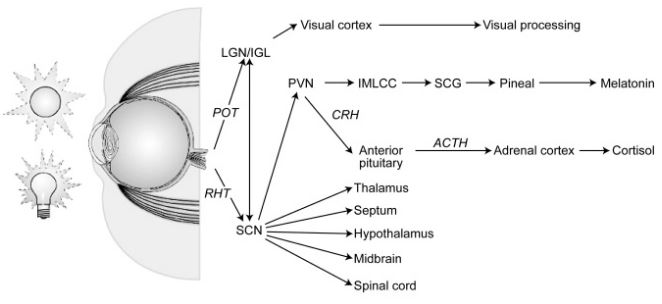Light Therapy
Lightwave Stimulation (LWS)
In addition to its role in vision, light exerts strong effects on behaviour. Its powerful role in the modulation of mood is well established, yet remains poorly understood.
There are physiological mechanisms, such as the pathway for light’s effects on the endocrine system through the retino-hypothalamic tract, which provide a scientific basis for beginning to understand the critical ways that light influences performance.
Our Light Therapy programme, known as Lightwave Stimulation (LWS), is intended to address light processing deficiencies which often seem to correlate with various learning, behavioural, reading and social difficulties. These may have profound effects on physical and emotional well-being.
The literature on coloured light indicates both the importance of light for the functioning of the body and its usefulness for psychological and emotional healing and light has a long history of therapeutic use. The more modern pioneers include Edwin Babbit, Auguste Rollier, Niels Finsen (Nobel Prize winner), Dinshah Ghadiali, Harry Riley Spitler, John Downing and Jacob Liberman.
When Lightwave Stimulation (LWS) has been used by us, many clients have reported improvements that include:
- Increased alertness
- Improved concentration
- Improved sleeping
- Improved eating or toileting patterns
- Reduced tantrums and aggressiveness
- Reduced impulsivity or overactive behaviour.
Who We Help
We have frequently found that constricted visual fields of awareness are related to inadequate functional visual abilities and overall learning and performance deficits.
Striking changes in quality of test results, symptom reductions, performance, behaviour and mood can occur as a result of Lightwave Stimulation (LWS).
Lightwave Stimulation (LWS) therapy may be helpful in association with:
- Low self-esteem
- Poor sleeping patterns
- Educational difficulties
- Anxiousness
- Socialisation difficulties
- Visual perceptual problems and reading difficulties
- Overactive or impulsive behaviour
- Eating problems, faddy eating
- Sadness
Therapy Following an assessment a personalised protocol is prepared. Lightwave Stimulation (LWS) involves looking at a low intensity, pulsed, coloured light, emitted by a Lumatron or Photron machine.
- The programme normally consists of two, 20-minute sessions each day for ten days.
- During treatment the client sits comfortably in a darkened room.
- The programme is individually tailored to each client.
- Lightwave Stimulation (LWS) is often used in combination with Auditory Integration Training (AIT).
- Wherever possible, we measure colour visual fields and visual perceptual profiles before and after treatment.
How Light Helps It is evident to most of us that light is required for vision, since without light we cannot see. What is not always recognised (but has been widely demonstrated) is that light also influences our eating and sleeping patterns, circadian rhythms, hormone production and regulation, emotional state and libido.
When light rays strike the retina of the eye, they are converted into nerve current, sometimes termed photocurrent, which travels via the optic nerve not only to the visual cortex but also to many other brain centres. These include the pineal gland and the hypothalamus, the brain’s master controller. Light thus effects not only our vision but also profoundly influences effective functioning of these other systems on which physical and emotional well-being depend.
Source: OCULAR LIGHTING EFFECTS ON HUMAN PHYSIOLOGY, MOOD, AND BEHAVIOUR (CIE 158:2004)
KEY: Light received by the eye is converted to neural signals that pass via the optic nerve to these visual and nonvisual pathways. POT = Primary optic tract. RHT = Retino-hypothalamic tract. LGN/IGL = Lateral geniculate nucleus / Intergeniculate leaflet. SCN = Suprachiasmatic nucleus of the hypothalamus. PVN = Paraventricular nucleus of the hypothalamus.IMLCC = Intermediolateral cell column of the spinal cord. SCG = Superior cervical ganglion. CRH = Corticotropic releasing hormone. ACTH = adrenocorticotropic hormone.
The rationale of Lightwave Stimulation (LWS) is that it stimulates the non-visual receptive system to respond more efficiently and use available light more effectively. In turn this can lead to improved mental, emotional and physical well-being resulting in enhanced performance in many areas.
